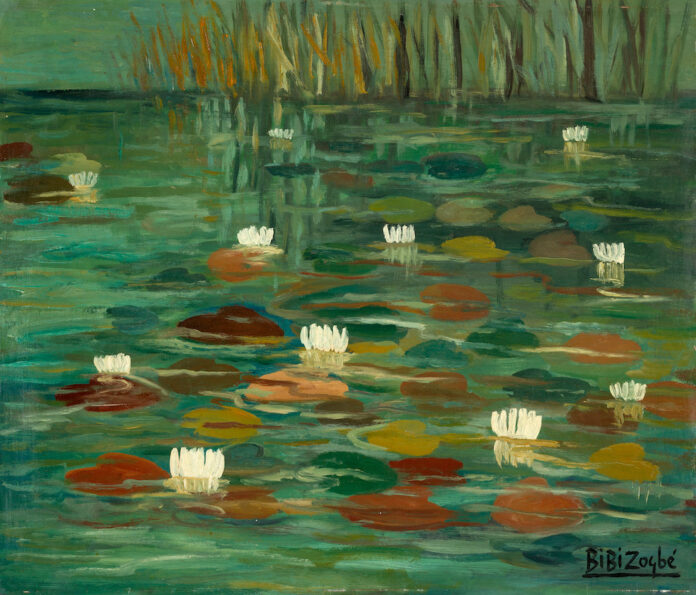DUBAI: “She was one of Lebanon’s pioneering artists — one of the first (female painters). But, in Lebanon, we didn’t know much about her.”
Lebanese gallerist Saleh Barakat is talking about the late Bibi Zogbe, a prolific artist who moved to Argentina from Lebanon in the early 20th century aged 16, where she predominantly focused on painting an eclectic array of flowers. Barakat believes Zogbe deserves greater recognition — both for her talent and her pioneering spirit.
Barakat believes Zogbe deserves greater recognition. (Supplied)
Over the last two decades, the gallerist has become a champion of Zogbe’s work, which had, he says, faded from her countrymen’s memories. It began with what he calls a “pilgrimage” to Argentina 17 years ago. For a month, Barakat traveled around meeting Zogbe’s friends, family and acquaintances, even visiting her home. He discovered some of her work in Argentinean museums. He has since acquired a considerable collection of her work. Simultaneously, international interest in Zogbe has greatly increased — her work regularly fetches five-figure sums at sales by auction houses including Christie’s and Sotheby’s. Some of her work was also featured in the Modern section of last month’s Art Dubai fair.
Zogbe (whose first name was actually Labibe) was born in a Lebanese coastal town. She studied under the tutelage of Klin Dimitrof, an artist from Bulgaria, but — while she was still a teenager — her marriage to Lebanese emigre Domingo Samaja was arranged, and Zogbe went off to Argentina. Later, when her marriage fell apart, Zogbe reportedly struck up a relationship with Argentinian artist Benito Quinquela Martin.
Celia De Diego, 1937. (Supplied)
The gifted and cosmopolitan Zogbe found great success in her adopted country. Her first solo exhibition was inaugurated by then-president of Argentina, Agustin Pedro Justo. She painted a floral mural for the Natural Science Museum in Buenos Aires. During the Thirties and Forties, she traveled abroad to exhibit in Paris and the presidential palace in Dakar. 1947 was a milestone year for Zogbe as she returned to Lebanon briefly, where she was awarded the Lebanese Cedar Medallion of Excellence.
Back in Argentina, Zogbe had established herself as a focal point for the country’s creative scene, Barakat explains. “She was one of the few people in Argentina to bring together simultaneously Argentinians of Euro-aristocratic origin and Argentinians of Indian origin,” he says. “They don’t mix that often. But it seems that she was good at cooking and people loved her soirees. Her house was a meeting point for writers, important people in society, and the cultured.”
Untitled, 1941. (Supplied)
It is surprising, then, that Zogbe is not better known. According to Sam Bardaouil, the Lebanese co-curator of Art Dubai Modern, it’s an issue concerning not just Zogbe, but many of her peers.
“I think it has to do with the fact that a lot of these artists were obscured by a very skewed writing of art history that was always generated from so-called centers of production and historical writing,” Bardaouil says. “I think, for years now, there’s this revisionist approach to art history to understand who these artists are and what their contributions were.”
Barakat suggests that the artist’s globe-trotting lifestyle was another factor. “In Argentina, they considered her Lebanese, and in Lebanon, they considered her Argentinian. She wasn’t in one place all the time,” he says. “Her paintings are here and there and she didn’t leave behind an estate. Like so many of these artists, her works have been slightly forgotten.”
Untitled, 1947. (Supplied)
Visitors to Art Dubai were able to observe Zogbe’s rare landscape and portrait works, inspired by her trips to Africa. But what took center stage were her paintings of dainty wild flowers, bursting with color and emotion. It is no wonder that Zogbe has been called ‘La Pintora de Flores’ (The Flower Painter).
“It’s a bit of a mirror image of where she’s been, who she met, what kind of cultural contexts she existed and worked in,” Bardaouil says of the work on show at Art Dubai. “As you start mapping out the different types of flowers that she paints, you realize that they’re actually a kind of memoir.”

